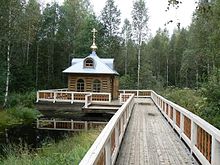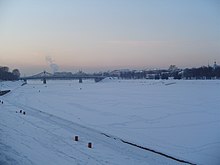Volga
![]()
The title of this article is ambiguous. For other meanings, see Volga (disambiguation).
The Volga (Russian Волга, Tatar Идел / İdel, Ersyan Рав, Mokshan Рава, Chuvash Атӑл, Meadow Mari Юл, Mountain Mari Йыл, Ancient Greek Ῥᾶ Rha) is a river in the European part of Russia. With a length of 3530 km, it is the longest and most water-rich river in Europe and one of the longest rivers on Earth (ranked 17th). The Volga is the longest endorheic river on Earth, making it one of the largest bodies of water that have no natural connection to the oceans.
The Volga rises in the Waldai Heights at 228 m above Baltic Sea level, flows initially eastwards, then southwards through the East European Plain and flows into the Caspian Sea at 28 m below Baltic Sea level. The difference in altitude between the source and the mouth is 256 m.
The Volga has about 200 major tributaries, its catchment area of 1.36 million km² area includes a total of 151,000 rivers, streams and temporary watercourses. At the lower reaches in Volgograd, the average annual discharge is 264 billion m³.
The river is navigable from its mouth into the Caspian Sea to its upper reaches and is the core of the waterway between the Black and Caspian Seas in the south and the Baltic and White Seas in the north. All barrages are equipped with locks. The Volga-Baltic Sea Canal connects the Volga with the Baltic Sea to the west, and the White Sea-Baltic Sea Canal, which branches off from the Volga-Baltic Sea Canal to the north, connects the Volga with the White Sea and thus also with the Arctic Ocean. Via the Volga-Don Canal and the Don River flowing to the west, it is connected to the Black Sea and the Mediterranean Sea.
History
Source and headwaters
The Volga River rises and runs in the western part of Russia. Its source is located in the Valday Heights near the village of Volgovskhovye (Волговерховье, 228 m).
After the water of the Volga flows down from the Waldai Heights, it reaches Rzhev and flows northeast from now on. From here small barges can navigate the river. Downstream is the city of Tver (1931-1990 Kalinin), which was founded in 1135 and lies on the trunk road from Moscow to Saint Petersburg. The Volga continues to flow through the Ivankovo Reservoir to Dubna, where it joins the Moscow Canal. The Dubna reservoir was built, among other things, to supply water to Moscow via the Moscow Canal. Via Kimry the river reaches the Uglitsch reservoir, which is dammed by a dam in Uglitsch. Further north, the Volga flows through the Rybinsk Reservoir, the oldest reservoir on the Volga. The Mologa, Suda, Sheksna and the Volga-Baltic Canal flow into this lake.
Middle course
Beyond the dam is Rybinsk (1946-1957 Shcherbakov and 1984-1991 Andropov), the largest transhipment port on the upper Volga. The Volga now flows southeast and reaches Yaroslavl, one of the oldest cities in central Russia, dating from the 11th century. Today's industry here discharges most of its wastewater untreated into the river. About 70 km downstream is Kostroma, an ancient city (founded in 1152) at the mouth of the river of the same name. Behind Kineschma the Volga is dammed again, here lies the 80 km long Gorky reservoir. In Nizhny Novgorod the Oka joins the Volga from the right, which now flows eastwards. Near Novocheboksarsk in the Republic of Chuvashia, the Volga is dammed to form the Cheboksarsk Reservoir. In the 1980s, tens of thousands of upriver Mari people were resettled to make way for the lake. Cheboksary is located on the reservoir. 150 km to the east is the city of Kazan, the capital of the Republic of Tatarstan, where the Volga turns south. The city lies at the upper end of the approximately 550 km long Kuibyshev Reservoir, which at 6450 km² is the largest reservoir on the Volga and in Europe. Here the Kama flows into the Volga. On the shore lie the cities of Ulyanovsk (formerly Simbirsk) and Tolyatti (also spelled Togliatti). On the Volga bend (Russian: Samarskaya luka) lies Samara (1935-1990 Kuibyshev), a city of millions. Here the river Samara flows into the Volga from the left. At the end of the Volga loop lies Sysran.
Lower reaches and estuary
The Saratov reservoir, which begins here, was dammed at Balakovo. Below this industrial city the Great Irgis flows into the Volga. Between Balakowo and Saratow the Volga Germans used to live, before they were deported to Siberia and Kazakhstan during the Second World War. Even today, however, the towns of Engels and Marx on the left bank are reminders of the German settlement. Only on this section the Volga is still as it used to be. The characteristic form of the mountain and meadow landscape - in the form of the up to 375 m high Volga plateau in the west and the flat meadow bank in the east - is common from Kazan to Volgograd, but the reservoirs flood parts of the bank regions. Only between Balakovo and Marx the Volga is still natural.
Opposite Engels and thus west of the Volga lies Saratov, a university city with about 880,000 inhabitants. Here begins the 600 km long Volgograd Dam, on the banks of which is the city of Kamyshin. Below the dam are the cities of Volshsky and Volgograd (formerly Tsaritsyn, Stalingrad), the latter of which stretches for 80 km along the west bank of the Volga.
At Volshsky, where the Volga delta begins, the Achtuba estuary branches off from the Volga, which is by far the longest of these arms and runs parallel (northeast) to the river. The Volga reaches the so-called Volgaknie behind Volgograd, where it bends to the southeast.
The Volga-Don Canal branches off to the west in the southern part of the city of Volgograd (since 1931 a district of Krasnoarmeiski, previously an independent village of Sarepta, from 1920 Krasnoarmeisk). It was dug between 1950 and 1957, mainly by camp prisoners, and provides a connection to the Sea of Azov and the Black Sea, and thus to the Mediterranean Sea, via the Don. Below Volgograd, the Volga gradually flows into the Caspian Depression, which joins the East European Plain to the southeast.
At about the beginning of the main area of the Volga Delta lies the city of Astrakhan (formerly Itil), from where the Volga Delta branches out into numerous estuaries. Parts of the delta are protected because the area is an important stopover for migratory birds and also the habitat of numerous other animal species. The large estuaries of the Volga include Bachtemir and Tabola in the west, between which the Volga flows; a little further east, the long estuary branch Achtuba flows.
The shore of the Caspian Sea is reached by the estuary branches of the Volga about 75 to 100 km south or southeast of Astrakhan. The height of the mouth on the shore of the lake is 28 m below sea level, which gives a gradient of 256 m between the source and the mouth.

Volga Spring

The banks of the Volga in Astrakhan

An arm of the Volga in the estuary

Frozen Volga in Tver

View of the Volga River from the vantage point near the monument to Valery Chkalov in Nizhny Novgorod. July 2014

Mouth of the Oka (left) in Nizhny Novgorod
Navigability
The Volga proper is today designated as an inland waterway from Rzhev to Krasnye Barrikady (below Astrakhan) over a length of 3193 km. In addition, there are waterways of 961 km on the Volga arms below Volgograd (such as Achtuba) and in the Volga delta, as well as 1806 km of alternative routes, port accesses and the like on the reservoirs below the Rybinsk reservoir. Above Rybinsk the Volga is navigable for smaller vessels on another 250 km (up to 10 km below the source) up to the Upper Volga Lakes (Sterschsch, Wselug, Peno and Wolgo), which are additionally dammed by a weir to the Upper Volga Reservoir since 1845, but not continuously due to missing or decommissioned locks. Accordingly, this section is no longer considered an inland waterway.
See also: Steam navigation on the Volga

Cruise ships on the Volga
Search within the encyclopedia